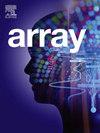Multimodal data fusion for Alzheimer's disease based on dynamic heterogeneous graph convolutional neural network and generative adversarial network
IF 2.3
Q2 COMPUTER SCIENCE, THEORY & METHODS
引用次数: 0
Abstract
Alzheimer's disease (AD) is a complex neurodegenerative disorder, and understanding its pathogenic mechanisms is crucial for accurate diagnosis. Current research has progressed from single-modal data analysis to multi-modal data fusion, leveraging deep learning's efficient data analysis capabilities to handle complex datasets. However, existing deep learning models primarily focus on homogeneous data, facing limitations in classification accuracy and interpretability. The complex and diverse causes of AD make it challenging to fully exploit the complementary information among different data types. To address these challenges, we propose a multi-modal data fusion method based on a Dynamic Heterogeneous Attention Network (DHAN) and Generative Adversarial Networks (GAN). The proposed method designs private graph convolutional layers and shared heterogeneous attention layers, combining dynamic graph structure updates and graph structure regularization to dynamically enhance inter-modal relationships. This approach integrates structural Magnetic Resonance Imaging (sMRI), Single Nucleotide Polymorphism (SNP), and gene expression (GENE) data. Additionally, GANs are utilized to generate synthetic data to augment the training set, enhancing the model's robustness and generalization ability. Experimental results demonstrate that the proposed DHAN-GAN model achieves outstanding performance in AD classification tasks, with an ACC reaching 92.31 %. The classification accuracy exceeds traditional methods by over 10 % and significantly outperforms other comparative models in metrics such as precision, recall, and F1 score. This study provides a novel and effective solution for the application of multi-modal data fusion in Alzheimer's disease classification.
基于动态异构图卷积神经网络和生成对抗网络的阿尔茨海默病多模态数据融合
阿尔茨海默病(AD)是一种复杂的神经退行性疾病,了解其发病机制对准确诊断至关重要。目前的研究已经从单模态数据分析发展到多模态数据融合,利用深度学习的高效数据分析能力来处理复杂的数据集。然而,现有的深度学习模型主要关注同构数据,在分类精度和可解释性方面存在局限性。AD的成因复杂多样,难以充分挖掘不同数据类型之间的互补信息。为了解决这些挑战,我们提出了一种基于动态异构注意网络(DHAN)和生成对抗网络(GAN)的多模态数据融合方法。该方法设计了私有的图卷积层和共享的异构关注层,结合图结构的动态更新和图结构的正则化来动态增强模态间的关系。该方法集成了结构磁共振成像(sMRI)、单核苷酸多态性(SNP)和基因表达(gene)数据。此外,利用gan生成合成数据来扩充训练集,增强模型的鲁棒性和泛化能力。实验结果表明,提出的DHAN-GAN模型在AD分类任务中取得了优异的性能,ACC达到了92.31%。分类精度超过传统方法10%以上,并且在精度、召回率和F1分数等指标上显著优于其他比较模型。本研究为多模态数据融合在阿尔茨海默病分类中的应用提供了一种新颖有效的解决方案。
本文章由计算机程序翻译,如有差异,请以英文原文为准。
求助全文
约1分钟内获得全文
求助全文

 求助内容:
求助内容: 应助结果提醒方式:
应助结果提醒方式:


